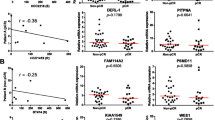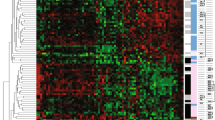Abstract
Pathologic complete response after neoadjuvant systemic treatment appears to be a valid surrogate for better overall survival in breast cancer patients. Currently, together with standard clinicopathologic assessment, novel molecular biomarkers are being exhaustively tested in order to look into the heterogeneity of breast cancer. The aim of our study was to examine an association between 23-gene real-time-PCR expression assay including ABCB1, ABCC1, BAX, BBC3, BCL2, CASP3, CYP2D6, ERCC1, FOXC1, GAPDH, IGF1R, IRF1, MAP2, MAPK 8, MAPK9, MKI67, MMP9, NCOA3, PARP1, PIK3CA, TGFB3, TOP2A, and YWHAZ receptor status of breast cancer core biopsies sampled before neoadjuvant chemotherapy (anthracycline and taxanes) and pathologic response. Core-needle biopsies were collected from 42 female patients with inoperable locally advanced breast cancer or resectable tumors suitable for downstaging, before any treatment. Expressions of 23 genes were determined by means of TagMan low density arrays. Analysis of variance was used to select genes with discriminatory potential between receptor subtypes. We introduced a correction for false discovery rates (presented as q values) due to multiple hypothesis testing. Statistical analysis showed that seven genes out of a 23-gene real-time-PCR expression assay differed significantly in relation to pathologic response regardless of breast cancer subtypes. Among these genes, we identified: BAX (p = 0.0146), CYP2D6 (p = 0.0063), ERCC1 (p = 0.0231), FOXC1 (p = 0.0048), IRF1 (p = 0.0022), MAP2 (p = 0.0011), and MKI67 (p = 0.0332). The assessment of core biopsy gene profiles and receptor-based subtypes, before neoadjuvant therapy seems to predict response or resistance and to define new signaling pathways to provide more powerful classifiers in breast cancer, hence the need for further research.

Similar content being viewed by others
References
Von Minckwitz G, Loibl S, Maisch A, Untch M (2011) Lessons from the neoadjuvant setting on how best to choose adjuvant therapies. Breast 20(Suppl 3):S142–S145
Marchio C, Sapino A (2011) The pathologic complete response open question in primary therapy. J Natl Cancer Inst Monogr 43:86–90
Arun BK, Dhinghra K, Valero V, Kau SW, Broglio K et al (2011) Phase III randomized trial of dose intensive neoadjuvant chemotherapy with or without G-CSF in locally advanced breast cancer: long-term results. Oncologist 16:1527–1534
Ena G (2011) Neoadjuvant therapy in breast cancer. Rev Med Brux 32:243–246
Vaklavas C, Forero-Tores A (2011) How do I treat triple negative disease? Curr Treat Options Oncol 12:369–388
Gonzalez-Angulo AM, Hennessy BT, Meric-Bernstam F, Sahin A, Liu W et al (2011) Functional proteomics can define prognosis and predict pathologic complete response in patients with breast cancer. Clin Proteomics 8(1):11
http://www.ncbi.nlm.nih.gov. Accessed 27 June 2010
http://www.genecards.org/cgi-bin/carddisp.pl. Accessed 13 Nov 2011
Sotiriou C, Pusztai L (2009) Gene-expression signatures in breast cancer. N Engl J Med 360(8):790–800
Hoeflich K (2011) PI3 K + MEK inhibition. Ann Oncol 22(suppl 2):ii23. doi:10.1093/annonc/mdr077
Fumagalli D, Desmedt C, Ignatiadis M, Loi S, Piccart M, Sotiriou C (2011) Gene profiling assay and application: the predictive role in primary therapy. J Natl Cancer Inst Monogr 43:124–127
Ray PS, Wang J, Qu Y, Sim MS, Shamonki JM et al (2010) FOXC1 is a potential prognostic biomarker with functional significance in basal- like breast cancer. Cancer Res 70(10):3870–3876. doi:10.1158/0008-5472
Ray PS, Bagaria SP, Wang J, Shamonki JM, Ye X et al (2011) Basal- like breast cancer defined by FOXC1 expression offers superior prognostic value: a retrospective immunohistochemical study. Ann Surg Oncol 18:3839–3847
Rody A, Holtrich U, Pusztai L, Liedtke C, Gaetje R et al (2009) T-cell metagene predicts a favorable prognosis in estrogen receptor- negative and HER2 positive breast cancers. Breast Cancer Res 11:R15
Cavalli LR, Riqqins RB, Wang A, Clarke R, Haddad BR (2010) Frequent loss of heterozygosity at the interferon regulatory factor -1 gene locus in breast cancer. Breast Cancer Res Treat 121:227–231
Teschendorff AE, Gomez S, Arenas A, El-Ashry D, Schmidt M et al (2010) Improved prognostic classification of breast cancer defined by antagonistic activation patterns of immune response pathway modules. BMC 10:604
Kim D, Jung W, Koo JS (2011) The expression of ERCC1, RRM1, and BRCA1 in breast cancer according to the immunohistochemical phenotypes. J Korean Med Sci 26:352–359
Chen X, Wu J, Lu H, Huang O, Shen K (2011) Measuring β-tubulin III, Bcl-2 and ERCC1 improves pathological complete remission predictive accuracy in breast cancer. Cancer Sci 103(2):262–268. doi:10.1111/j.1349-7006.2011.02135.x
Shao YY, Kuo KT, Hu FC, Lu JS, Huang CS et al (2010) Predictive and prognostic values of tau and ERCC1 in advanced breast cancer patients treated with paclitaxel and cisplatin. Jpn J Clin Oncol 40:286–293
Silver DP, Richardson AL, Eklund AC, Wang ZC, Szallasi Z et al (2010) Efficacy of neoadjuvant cis-platin in triple negative breast cancer. J Clin Oncol 28:1145–1153
Iwamoto T, Pusztai L (2010) Predicting prognosis of breast cancer with gene signatures: are we lost in a sea of data? Genome Med 2:81
Tordai A, Wang J, Andre F, Liedtke C, Yan K et al (2008) Evaluation of biological pathways involved in chemotherapy response in breast cancer. Breast Cancer Res 10(2):R37. doi:10.1186/bcr2088
Fan C, Prat A, Parker JS, Liu Y, Carey A et al (2011) Building prognostic models for breast cancer patients using clinical variables and hundreds of gene expression signatures. BMC Medical Genomics 4:3
Nielsen TO, Parker JS, Leung S, Voduc D, Ebbert M et al (2011) A comparison of PAM50 intrinsic subtyping with immunohistochemistry and clinical prognostic factors in tamoxifen-treated estrogen receptor positive breast cancer. Clin Cancer Res 16:5222–5232
Froehlich H (2011) Network based consensus gene signatures for biomarker discovery in breast cancer. Plos one 6(10):e25364. doi:10.1371/journal.pone.0025364
Gabrovska PN, Smith RA, Tiang T, Weinstein SR, Haupt LM, Griffiths LR (2011) Development of an eight gene expression profile implicating human breast tumours of all grades. Mol Biol Rep (in press)
Acknowledgment
This work was supported by the grant of the Ministry of Science, Poland, NN402350838.
Conflict of interest
None
Author information
Authors and Affiliations
Corresponding author
Rights and permissions
About this article
Cite this article
Kolacinska, A., Fendler, W., Szemraj, J. et al. Gene expression and pathologic response to neoadjuvant chemotherapy in breast cancer. Mol Biol Rep 39, 7435–7441 (2012). https://doi.org/10.1007/s11033-012-1576-1
Received:
Accepted:
Published:
Issue Date:
DOI: https://doi.org/10.1007/s11033-012-1576-1




